| Revision as of 18:02, 9 October 2013 editFakirbakir (talk | contribs)Extended confirmed users12,899 edits Reverted 1 edit by 79.117.177.89 (talk): Obama is an American or a Kenyan guy? (TW)← Previous edit | Revision as of 00:46, 13 October 2013 edit undoShokatz (talk | contribs)Extended confirmed users2,194 edits Undid revision 571551271 by Norden1990 (talk) Let's stick with the main infobox, shall we? As for the examples given Dalmatia WAS Croatia in this period. Rama and Jersualem were titular.Next edit → | ||
| Line 180: | Line 180: | ||
| |- | |- | ||
| {{S-vac| rows=1 | last=]}} | {{S-vac| rows=1 | last=]}} | ||
| {{S-ttl| rows=1 | title=]| years=1458–1490}} | {{S-ttl| rows=1 | title=] and ]| years=1458–1490}} | ||
| {{S-aft| rows=2 | after=]}} | {{S-aft| rows=2 | after=]}} | ||
| {{S-bef| rows=1 | before=]}} | {{S-bef| rows=1 | before=]}} | ||
Revision as of 00:46, 13 October 2013
King of Hungary and Croatia| Matthias Corvinus | |
|---|---|
 | |
| King of Hungary and Croatia | |
| Reign | 20 January 1458 – 6 April 1490 |
| Coronation | 1464 |
| Predecessor | Ladislaus V |
| Successor | Vladislaus II |
| Regent | Michael Szilágyi (1458) |
| Duke of Austria | |
| Reign | 1486–1490 |
| King of Bohemia | |
| Reign | 1469–1490 |
| Predecessor | George |
| Successor | Vladislaus II |
| Born | 23 February 1443 Kolozsvár, Kingdom of Hungary (now Cluj-Napoca, Romania) |
| Died | 6 April 1490 (1490-04-07) (aged 47) Vienna, Austria, Holy Roman Empire |
| Spouse | Catherine of Poděbrady Beatrice of Naples |
| Issue | John Corvinus |
| House | House of Hunyadi |
| Father | John Hunyadi |
| Mother | Erzsébet Szilágyi |
Matthias Corvinus (Template:Lang-hu or very rarely Corvin Mátyás) (23 February 1443 – 6 April 1490), also called the Just in folk tales, was King of Hungary (as Matthias I) and Croatia from 1458, at the age of 14 until his death. After conducting several military campaigns he became also King of Bohemia (1469–1490), and Duke of Austria (1486–1490). With his patronage Hungary became the first European country which adopted the Renaissance from Italy. As a Renaissance ruler, he established education institutions, patronized art and science, and introduced a new legal system in the Kingdom of Hungary. In the era of his kingship, Matthias strongly endeavored to follow the model and ideas of the philosopher-king as described in Plato’s Republic.
Names in other languages
Medieval Latin: Mattias Corvinus, Romanian: Matia/Matei/Mateiaş Corvin/Corvinul, Croatian: Matija/Matijaš Korvin, Czech: Matyáš Korvín, German: Matthias Corvinus, Italian: Mattia Corvino, Polish: Maciej Korwin, Rusyn:Матяш Корвiн/Matiash Corvin, Serbian: Матија Корвин/Matija Korvin, Slovak: Matej Korvín, Slovene: Matija Korvin, Russian: Матьяш Корвин/Matyash Korvin, Ukrainian: Матвій Корвін.
Early life
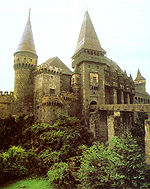
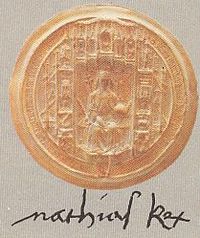

.
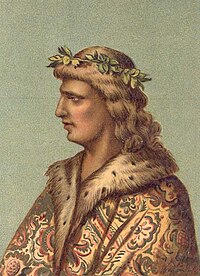
Matthias was born in Kolozsvár (Kingdom of Hungary, now Cluj-Napoca, Romania) in a house now known as the Matthias Corvinus House. He was second son of John Hunyadi, a successful general of the Kingdom of Hungary, who had risen through the ranks of the nobility to become regent of Hungary. Matthias' mother was Erzsébet Szilágyi, from a Hungarian noble family.
His tutors were the learned János Vitéz, bishop of Várad (now: Oradea), whom he subsequently raised to the primacy, and the Polish humanist Gregory of Sanok. Besides the learned languages, he was acquainted with most of the living tongues of Europe of the time. His military training proceeded under the eye of his father, whom he began to follow on his campaigns when he was only twelve years old. In 1453 he was created count of Beszterce (Bistriţa) in Transylvania, and was knighted at the Siege of Belgrade in 1456.
The same care for his welfare led his father to choose him a bride from the powerful family of the Counts of Cilli. Matthias was married to Elizabeth of Celje. She was the only known daughter of Ulrich II of Celje and Catherine Cantakuzina. Her maternal grandparents were Đurađ Branković and Eirene Kantakouzene. But Elizabeth died at the age of fifteen on 6 November 1455, before the marriage was consummated, leaving Matthias a widower at the age of twelve.
After the death of Matthias's father, there was a two-year struggle between Hungary's various barons and its Habsburg king, Ladislaus the Posthumous (also king of Bohemia), with treachery from all sides. Matthias's older brother Ladislaus Hunyadi was one party attempting to gain control. Matthias was inveigled to Buda by the enemies of his house, and, on the pretext of being concerned in a purely imaginary conspiracy against Ladislaus, was condemned to decapitation, but was spared on account of his youth. In 1457, Ladislaus Hunyadi was captured with a trick and beheaded, while the king died suddenly in November that year; rumors of poisoning were dispelled by research in 1985 which gave acute leukemia as the cause of death. Matthias was taken hostage by George of Poděbrady, governor of Bohemia, a friend of the Hunyadis who aimed to raise a national king to the Hungarian throne. Poděbrady treated Matthias hospitably and affianced him with his daughter Kunhuta (later known as Catherine), but still detained him, for safety's sake, in Prague, even after a Hungarian deputation had hastened thither to offer the youth the crown. Matthias took advantage of the memory left by his father's deed, and by the general population's dislike of foreign candidates; most of the barons, furthermore, considered that the young scholar would be a weak monarch in their hands. The Diet met in Buda to elect a new king. The people of Buda and Pest also came to the streets of Buda to support the election of the young Matthias Hunyadi as King of Hungary. The townsfolk favoured Hunyadi's son, however the majority of the nobles were largely opposed. An influential section of the magnates, headed by the Palatine Ladislaus Garai and by Nicholas of Ilok, voivode of Transylvania, who had been concerned in the judicial murder of Matthias's brother Ladislaus, and hated the Hunyadis as semi-foreign upstarts, were fiercely opposed to Matthias's election. Meanwhile Matthias's uncle count Mihály Szilágyi and his 15,000 veterans unexpectedly arrived in Buda, thus the opponent party (which consisted of the members of the higher aristocracy) was not strong enough to resist. On 20 January 1458, Matthias was elected king by the Parliament. On the 24th of January 1458, 40,000 Hungarian noblemen, assembled on the ice of the frozen Danube, unanimously elected Matthias Hunyadi King of Hungary. Thus, on the 14th of February the new king made his state entry into Buda.
Rule
Early rule

 Forints of Matthias
Forints of Matthias
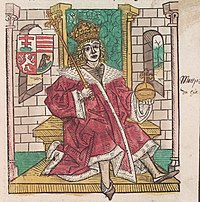
This was the first time in the medieval Hungarian kingdom that a member of the nobility, without dynastic ancestry and relationship, mounted the royal throne. Such an election upset the usual course of dynastic succession in the age. In the Bohemian and Hungarian states they heralded a new judiciary era in Europe, characterized by the absolute supremacy of the Parliament, (dietal system) and a tendency to centralization. During his reign, Matthias reduced the power of the feudal lords, and ruled instead with a cadre of talented and highly educated individuals, chosen for their abilities rather than their social status. That deed made many aristocrats hostile towards Matthias' new type of central government.
Matthias was 15 when he was elected King of Hungary: at this time the realm was environed by perils. The Ottomans and the Venetians threatened it from the south, the emperor Frederick III from the west, and Casimir IV of Poland from the north, both Frederick and Casimir claiming the throne. The Czech mercenaries under Jiskra held the northern counties and from thence plundered those in the centre. Meanwhile Matthias's friends had only pacified the hostile dignitaries by engaging to marry the daughter of the palatine Garai to their nominee, whereas Matthias refused to marry into the family of one of his brother's murderers, and on 9 February confirmed his previous nuptial contract with the daughter of Poděbrady, who shortly afterwards was elected King of Bohemia (2 March 1458). Throughout 1458 the struggle between the young king and the magnates, reinforced by Matthias's own uncle and guardian Szilágyi, was acute. But Matthias, who began by deposing Garai and dismissing Szilágyi, and then proceeded to levy a tax, without the consent of the Diet, in order to hire mercenaries, easily prevailed. He recovered the Golubac Fortress from the Ottomans, successfully invading Serbia, and reasserting the suzerainty of the Hungarian crown over Bosnia. In the following year there was a fresh rebellion, when the emperor Frederick was actually crowned king by the malcontents at Vienna-Neustadt (4 March 1459); Matthias however drove him out, and Pope Pius II intervened so as to leave Matthias free to engage in a projected crusade against the Ottomans, which subsequent political complications, however, rendered impossible. On 1 May 1461, the marriage between Matthias and Poděbrady's daughter took place.
From 1461 to 1465 the career of Matthias was a perpetual struggle punctuated by truces. Having come to an understanding with his father-in-law Poděbrady, he was able to turn his arms against the emperor Frederick. In April 1462 the latter restored the holy crown for 60,000 ducats and was allowed to retain certain Hungarian counties with the title of king; in return for which concessions, extorted from Matthias by the necessity of coping with a simultaneous rebellion of the Magyar noble in league with Poděbrady's son Victorinus, the emperor recognized Matthias as the actual sovereign of Hungary. Only now was Matthias able to turn against the Ottomans, who were again threatening the southern provinces. He began by defeating the Ottoman general Ali Pasha, and then penetrated into Bosnia, capturing the newly built fortress of Jajce after a long and obstinate defence (December 1463). On returning home he was crowned with the Holy Crown on 29 March 1464. Twenty-one days after, on 8 March, the 15-year-old Queen Catherine died in childbirth. The child, a son, was stillborn.
After driving the Czechs out of his northern counties, he turned southwards again, this time recovering all the parts of Bosnia which still remained in Ottoman hands.
Wars in central Europe
Main articles: Black Army of Hungary, Bohemian War (1468-1478), and Austrian-Hungarian War (1477-1488)

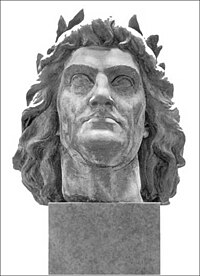
Matthias gained independence of and power over the barons by dividing them, and by raising a large royal army, fekete sereg (the King's Black Army of mercenaries), whose main force included the remnants of the Hussites from Bohemia. At this time Hungary reached its greatest territorial extent of the epoch (present-day southeastern Germany to the west, Dalmatia to the south, Eastern Carpathians to the east, and southwestern Poland to the north).
Soon after his coronation, Matthias turned his attention upon Bohemia, where the Hussite leader George of Poděbrady had gained the throne. The election took place on a field, in the presence of about 10,000 electors. In order to obtain as many votes as necessary he made various businesses with the key-persons, but he did not expect this many electors, so he needed more money. Two of the most significant persons were Gašpar Ernušt Hampo de Csaktornya, who was a rich wholesaler of copper and who lent money to him to be able to make the businesses there at the election before the coronation and Simon Keglević, who became the commander of Matthias Corvinus. In 1465 Pope Paul II excommunicated the Hussite King and ordered all the neighbouring princes to depose him. On 31 May 1468, Matthias invaded Bohemia; however, as early as 27 February 1469, he anticipated an alliance between George and Frederick by himself concluding an armistice with the former . On 3 May the Bohemian Catholics elected Matthias king of Bohemia, but this was contrary to the wishes of both pope and emperor, who preferred to partition Bohemia. George however anticipated all his enemies by suddenly excluding his own son from the throne in favour of Ladislaus, the eldest son of Casimir IV , thus skillfully enlisting Poland on his side . The sudden death of Poděbrady in March 1471 led to fresh complications. At the very moment when Matthias was about to profit by the disappearance of his most capable rival, another dangerous rebellion, headed by the primate and the chief dignitaries of the state, with the object of placing Casimir, son of Casimir IV, on the throne, paralysed Matthias's foreign policy during the critical years 1470–1471. He suppressed this domestic rebellion indeed, but in the meantime the Poles had invaded the Bohemian domains with 60,000 men, and when in 1474 Matthias was at last able to take the field against them in order to raise the siege of Breslau, he was obliged to fortify himself in an entrenched camp, whence he so skillfully harried the enemy that the Poles, impatient to return to their own country, made peace at Breslau (February 1475) on an uti possidetis basis, a peace subsequently confirmed by the Peace of Olomouc (July 1479).
During the interval between these peaces, Matthias, in self-defence, again made war on the emperor, reducing Frederick to such extremities that he was glad to accept peace on any terms. By the final arrangement made between the contending princes, Matthias recognized Ladislaus as king of Bohemia proper in return for the surrender of Moravia, Silesia and Upper and Lower Lusatia, hitherto component parts of the Bohemian monarchy, till he should have redeemed them for 400,000 florins. The emperor promised to pay Matthias a huge war indemnity, and recognized him as the legitimate king of Hungary on the understanding that he should succeed him if he died without male issue, a contingency at this time somewhat improbable, as Matthias, only three years previously (15 December 1476), had married his third wife, Beatrice, daughter of Ferdinand I of Naples.
The emperor's failure to follow through on these promises induced Matthias to declare war against him for the third time in 1481. The Hungarian king conquered all of the fortresses in Frederick's hereditary domains. Finally, on 1 June 1485, at the head of 8,000 veterans, he made his triumphal entry into Vienna, which he henceforth made his capital. Styria, Carinthia and Carniola were next subdued; Trieste was only saved by the intervention of the Venetians. Matthias consolidated his position by alliances with the dukes of Saxony and Bavaria, with the Swiss Confederation and the archbishop of Salzburg, establishing henceforth the greatest potentate in central Europe.
Wars against the Ottoman Empire

In 1471 Matthias renewed the Serbian Despotate in south Hungary under Vuk Grgurević for the protection of the borders against the Ottomans. In 1479 a huge Ottoman army, on its return home from ravaging Transylvania, was annihilated at Szászváros (modern Orăştie, 13 October 1479) in the so-called Battle of Breadfield. The following year Matthias recaptured Jajce, drove the Ottomans from northern Serbia and instituted two new military banats, Jajce and Srebernik, out from reconquered Bosnian territory.
In 1480, when an Ottoman fleet seized Otranto in the Kingdom of Naples, Matthias sent the Hungarian general, Balázs Magyar, at the earnest solicitation of the pope, to recover the fortress, which surrendered to him on 10 May 1481. Again in 1488, Matthias took Ancona under his protection for a while, occupying it with a Hungarian garrison.
On the death of sultan Mehmet II in 1481, a unique opportunity for the intervention of Europe in Ottoman affairs presented itself. A civil war ensued in the Ottoman Empire between his sons Bayezid and Cem; the latter, being worsted, fled to the knights of Rhodes, by whom he was kept in custody in France. Matthias, as the next-door neighbour of the Ottomans, claimed the custody of so valuable a hostage, and would have used him as a means of extorting concessions from Bayezid. But neither the pope nor the Venetians would accept such a transfer, and the negotiations on this subject greatly embittered Matthias against the Papal court. The last days of Matthias were occupied in endeavouring to secure the succession to the throne for his illegitimate son John; Queen Beatrice, though childless, fiercely and openly opposed the idea and the matter was still pending when Matthias, who had long been crippled by gout, expired very suddenly on 6 April 1490, just before Easter.
Policies in Wallachia and Moldavia
At times Matthias had Vlad III the Impaler (his second degree cousin, known to Romanians as Vlad Țepeș), Prince of Wallachia, as his ally. Although Vlad had great success against the Ottoman armies, the two Christian rulers disagreed in 1462, leading to Matthias imprisoning Vlad in Buda. However, wide-ranging support from many Western leaders for Vlad III prompted Matthias to gradually grant privileged status to his controversial prisoner. Vlad was eventually freed and married Matthias' cousin, Ilona Szilagyi. As the Ottoman Empire appeared to be increasingly threatening as Vlad Țepeș had warned, he was sent to reconquer Wallachia with Hungarian support in 1476. Despite the earlier disagreements between the two leaders, it was ultimately a major blow to Hungary's status in Wallachia when Vlad was assassinated that same year.
In 1467, a conflict erupted between Matthias and the Moldavian Prince Stephen III (Romanian: Ștefan cel Mare), after the latter became weary of Hungarian policies in Wallachia and their presence at Kilia; added to this was the fact that Matthias had already taken sides in the Moldavian conflicts preceding Stephen's rule, as he had backed Alexăndrel (and, possibly, the ruler referred to as Ciubăr Vodă), deposing Petru Aron. Stephen occupied Chilia (Kilia), sparking Hungarian retaliation, that ended in Matthias' defeat in the Battle of Baia in December (the King himself is said to have been wounded thrice).
Matthias and Stephen III concluded an anti-Ottoman alliance in July 1475.
In 1489, Matthias Corvinus donated Stephen III two Transylvanian estates as a token of this cooperation: the fortress of Ciceu (Csicsóvár) with 60 villages and Cetatea de Balta (Küküllővár) with 7 villages, probably as compensation for losing Chilia and Cetatea Alba to the Ottomans
Patronage
See also: History of Buda Castle and Visegrád


Matthias was educated in Italian, and his fascination with the achievements of the Italian Renaissance led to the promotion of Italian cultural influences in Hungary. Buda, Esztergom, Székesfehérvár and Visegrád were amongst the towns in Hungary that benefited from the establishment of public health and education institutions and a new legal system under Matthias' rule. In 1465, he founded a university in Pressburg (Bratislava), the Universitas Istropolitana which was the third university in medieval Hungary. His 1476 marriage to Beatrice, the daughter of the King of Naples, only intensified the influence of the Renaissance.
During the long reign of emperor Sigismund of Luxemburg, the so-called Fresh Palace of the Royal residence of Buda became probably the largest Gothic palace of the late Middle Ages. Matthias rebuilt the palace in early Renaissance style and further expanded it. His other favourite residence was the summer palace of Visegrád.
Italian city-states and Western Europe were present in large numbers at his court. The most important humanists living in Matthias' court were Antonio Bonfini, Galeotto Marzio, Pietro Ranzano, Marsilio Ficino, Aurelio Lippo Brandolini and the Hungarian poet Janus Pannonius. Famous Italian artists served the king: Filippino Lippi, Andrea del Verrocchio, Benedetto da Maiano, Andrea Mantegna, Giovanni Dalmata, and Cristoforo Foppa. The young Leonardo da Vinci met Matthias in the spring of 1485, where Leonardo painted a Madonna painting in the Visegrád Palace for the king. In his „Treaty on the Painting“ Leonardo da Vinci describes his conversation with king Matthias on the King’s birthday, when the King received his fiancée’s portrait. Leonardo’s description is almost a report showing his first hand knowledge of the King’s love for painting, his Platonic philosophy and the customs of his court. Verrocchio painted many portraits of famous historical persons for king Matthias. As Galeotto Marzio tells us, Hungarian 'heroic sagas', and love songs were often sung on special occasions in the king's court alongside the international, 'modern' Burgundian-Flandrian music. The famous renaissance cartographer Francesco Rosselli lived at the court of Matthias (1476-1484) where he made many detailed maps of the known world for the king Astronomer Johannes Regiomontanus built astrolabes for Matthias Corvinus of Hungary. There he calculated extensive astronomical tables and built astronomical instruments for the king. Like many of his acculturated contemporaries, he trusted in astrology and other semi-scientific beliefs; however, he also supported true scientists and engaged frequently in discussions with philosophers and scholars. A comparison of Republics and Kingdoms and other governmental forms was a feature of a three-day discussion between the Florentine merchant Domenico Giugni and the Hungarian monarch Matthias Corvinus cleverly assembled by the humanist scholar Aurelio Lippo Brandolini. This was the first and only political debate where Republics and Kingdoms and other governmental forms were systematically compared in the renaissance era.
Royal library
Matthias Corvinus's library, the Bibliotheca Corviniana, was Europe's greatest collections of secular books: historical chronicles, philosophic and scientific works in the fifteenth century. His library was second in size only to the Vatican Library. In 1489, Bartolomeo della Fonte of Florence wrote that Lorenzo de' Medici founded his own Greek-Latin library encouraged by the example of the Hungarian king. Frequently, half his nights were spent in reading, after the labour of his most strenuous days.
Legacy
In the course of his expansion, Matthias strengthened his state's diplomacy. Apart from his regular network of relations with his neighbours, as well as the Pope and Kingdom of Naples, he established regular contacts with France, Burgundy, Switzerland, Florence, most German states, Russia and, occasionally, with Persia and Egypt.
Matthias's empire collapsed after his death, since he had no children except for an illegitimate son, John Corvinus, whom the noblemen of the country did not accept as their king. Matthias' rival as King of Bohemia, Ladislaus II of the Jagiellon line, followed him.
High taxes, mostly falling on peasants, to sustain Matthias' lavish lifestyle and the Black Army (cumulated with the fact that the latter went on marauding across the Kingdom after being disbanded upon Matthias's death) could imply that he was not very popular with his contemporaries. But the fact that he was elected king in a small anti-Habsburg popular revolution, that he kept the barons in check, persistent rumours about him sounding public opinion by mingling among commoners incognito, and harshness of the period witnessed by Hungary later ensured that Matthias' reign is considered one of the most glorious chapters of Hungarian history. Songs and tales refer to him as Matthias the Just (Mátyás, az igazságos in Hungarian), a ruler of justice and great wisdom, and he is arguably the most popular hero of Hungarian folklore. There is a Hungarian proverb still used today saying Matthias has died, justice is gone (Meghalt Mátyás, oda az igazság). He is also one of the sleeping kings, particularly as King Matjaž in Slovenia.
This popularity is partially mirrored in modern Romania: 19th century Romantic nationalism invested in Matthias and his father's Vlach roots, their Christian warrior stances, and their cultural achievements.
Titles
His titles in the 1486 laws: King of Hungary, Bohemia, Dalmatia, Croatia, Rama, Serbia, Lodomeria, Cumania and Bulgaria, Prince of Silesia and Luxembourg, Margrave of Moravia and Lusatia.
Gallery
- Matthias Church in Budapest Matthias Church in Budapest
-
 Statue of Matthias Corvinus in front of St. Michael's Church in Cluj-Napoca, Romania, the city where he was born
Statue of Matthias Corvinus in front of St. Michael's Church in Cluj-Napoca, Romania, the city where he was born
-
 Matthias as a figure of Romance: The Mátyás Fountain, Budapest (Alajos Stróbl, 1902)
Matthias as a figure of Romance: The Mátyás Fountain, Budapest (Alajos Stróbl, 1902)
-
 Bronze bust of Matthias in National Historical Memorial Park of Ópusztaszer
Bronze bust of Matthias in National Historical Memorial Park of Ópusztaszer
-
 Matthias Statue in the Heroes Square, Budapest
Matthias Statue in the Heroes Square, Budapest
-
 Mátyás Hunyadi memorial coin (Coins of the Hungarian forint, by László Szlávics, Jr., 2008)
Mátyás Hunyadi memorial coin (Coins of the Hungarian forint, by László Szlávics, Jr., 2008)
-
 Matthias on the 1000 Hungarian forint banknote
Matthias on the 1000 Hungarian forint banknote
Notes
- Matthias I. (2009). In Encyclopædia Britannica. http://www.britannica.com/EBchecked/topic/369772/Matthias-
- In English, his first name is occasionally given as Matthew, while Corvinus may be rendered as Corwin or Corvin
- Peter Farbaky, Louis A. Waldman (7 November 2011). Italy & Hungary: Humanism and Art in the Early Renaissance. Harvard University Press. Retrieved 6 March 2012.
- Tanner, Marcus. The Raven King: Matthias Corvinus and the Fate of his Library. Yale University Press, 2008. pp 52.
- http://integralleadershipreview.com/5397-feature-article-marsilio-ficino-magnus-of-the-renaissance-shaper-of-leaders
- Stanley Sandler, Ground warfare: an international encyclopedia, Volume 1, ABC-CLIO, 2002, p. 391
- Charles William Russell, The life of Cardinal Mezzofanti: with an introductory memoir of eminent linguists, ancient and modern, Longman, Brown, and co., 1858, page 113.
- Template:MLCC in Medieval Lands by Charles Cawley
- http://www.guide-to-castles-of-europe.com/matthias-corvinus.html
- Valery Rees: Hungary's Philosopher King: Matthias Corvinus 1458–90 (Published 1994)|
- http://mek.oszk.hu/01900/01919/html/index1.html
- The Jews of Hungary: history, culture, psychology, page 82, Raphael Patai, Wayne Univ. Press, Detroit 1996. ISBN 0-8143-2561-0
- Șerban Papacostea, Stephen the Great: Prince of Moldavia, 1457-1504
- Gerard Labuda, The history of Polish diplomacy X-XX c
- Mihai Bǎrbulescu, The History of Transylvania: Until 1541
- Mircea Babes Politica externă a României: dict̨ionar cronologic
- History section: Miklós Horler: Budapest műemlékei I, Bp: 1955, pp. 259–307
- Post-war reconstruction: László Gerő: A helyreállított budai vár, Bp, 1980, pp. 11–60.
- http://www.artist-biography.info/artist/andrea_verrocchio
- A History of Western Architecture
- http://www.invaluable.com/artist/caradosso-56zr9byht1
- Franz-Joachim Verspohl: Michelangelo Buonarroti und Leonardo Da Vinci: Republikanischer Alltag und Künstlerkonkurrenz in Florenz zwischen 1501 und 1505 (page: 151)
- Prokopp, Mária: review of: Jenő Váralljai Csocsány, A magyar monarchia és az európai reneszánsz, Pomáz: (Kráter, 2005)|
- Larry J. Feinberg: The Young Leonardo: Art and Life in Fifteenth-Century Florence (page: 47)
- Roy Porter, Mikuláš Teich, The Renaissance in national context, Cambridge University Press,1992, page 173
- International Society for the History of Cartography: Imago Mvndi (page:24)
- http://press.princeton.edu/books/maor/sidebar_c.pdf
- Aurelio Lippo Brandolini, this was the first and only debate Republics and Kingdoms Compared. Edited and translated by James Hankins. I Tatti Renaissance Library Series. Cambridge: Harvard University Press, 2009. 336 pp. , ISBN 978-0-674-03398-6
- J. H. Burns: The Cambridge History of Political Thought 1450-1700
- Marcus Tanner, The Raven King: Matthias Corvinus and the Fate of his Lost Library (New Haven: Yale U.P., 2008)
-
 Chisholm, Hugh, ed. (1911). Encyclopædia Britannica (11th ed.). Cambridge University Press.
Chisholm, Hugh, ed. (1911). Encyclopædia Britannica (11th ed.). Cambridge University Press. {{cite encyclopedia}}: Missing or empty|title=(help) - Lukács, István. 2010. King Matthias Corvinus in the Collective Memory of the Slovenian Nation. Studia Slavica 55(2): 371–379.
- http://www.1000ev.hu/index.php?a=3¶m=876
Sources
- [REDACTED] This article incorporates text from a publication now in the public domain: Chisholm, Hugh, ed. (1911). "Matthias I., Hunyadi". Encyclopædia Britannica (11th ed.). Cambridge University Press.
Further reading
- Christian Gastgeber – Ekaterini Mitsiou – Ioan Aurel Pop – Mihailo Popović – Johannes Preiser-Kapeller – Alexandru Simon (Hrsg.): Matthias Corvinus und seine Zeit. Europa am Übergang vom Mittelalter zur Neuzeit zwischen Wien und Konstantinopel. Veröffentlichungen zur Byzanzforschung 27 (Verlag der Österreichischen Akademie der Wissenschaften). Vienna 2011, ISBN 978-3-7001-6891-1 (table of contents: http://hw.oeaw.ac.at/6891-1inhalt/Gastgeber_020_Inhaltsverzeichnis_005-006.pdf)
External links
- The Squash and the Colt, a folk tale reflecting Matthias' wisdom and sense of justice
- His picture on the Hungarian 1000 forint banknote
- Bibliotheca Corviniana Digitalis – National Széchényi Library, Hungary
- Map of Europe in 1500.
- Herbermann, Charles, ed. (1913). "Matthias Corvinus" . Catholic Encyclopedia. New York: Robert Appleton Company.
| Matthias Corvinus House of Hunyadi Born: 23 February 1443 Died: 6 April 1490 | ||
| Regnal titles | ||
|---|---|---|
| VacantTitle last held byLadislaus V | King of Hungary and Croatia 1458–1490 |
Succeeded byVladislaus II & I |
| Preceded byGeorge | King of Bohemia (disputed) 1469–1490 | |
| Catholic Church titles | ||
| Preceded byJohn Vitéz | Commendator of Pannonhalma Archabbey 1472–1490 |
Succeeded byTamás Bakócz |
| Monarchs of Bohemia | |||
|---|---|---|---|
| Přemyslid |  | ||
| Non-dynastic |
| ||
| Luxembourg |
| ||
| Habsburg |
| ||
| Non-dynastic |
| ||
| Jagiellonian |
| ||
| Habsburg |
| ||
| Habsburg-Lorraine |
| ||
| |||
| Monarchs of Hungary | ||||||
|---|---|---|---|---|---|---|
| Family tree | ||||||
| House of Árpád |
|  | ||||
| House of Přemysl |
| |||||
| House of Wittelsbach |
| |||||
| Capetian House of Anjou |
| |||||
| House of Luxembourg |
| |||||
| House of Habsburg |
| |||||
| House of Jagiellon |
| |||||
| House of Hunyadi |
| |||||
| House of Jagiellon |
| |||||
| House of Zápolya |
| |||||
| House of Habsburg |
| |||||
| House of Habsburg-Lorraine |
| |||||
| Debatable or disputed rulers are in italics. | ||||||
Categories:
- Use dmy dates from September 2010
- People from Cluj-Napoca
- Roman Catholic monarchs
- Hungarian monarchs
- Croatian monarchs
- Hungarian Roman Catholics
- Hungarian people of Romanian descent
- Hunyadi family
- History of Cluj-Napoca
- Pretenders to the Bohemian throne
- History of Hungary
- 15th-century Hungarian people
- Hungarian nobility
- Burials at Székesfehérvár Cathedral
- 1443 births
- 1490 deaths
- Hungarian book and manuscript collectors
- World Digital Library related